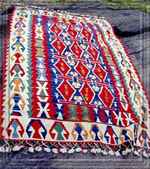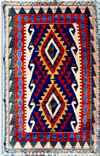|
|
|
A Short History of the Kilim
|
|
|
|
|
|
|
|
|
|
|
 |
|
|
|
|
Kilims
are Turkish rugs which come from the Anatolian Plateau in Central Turkey, also
called "Cappadocia" . The rugs have always been woven entirely by hand, the
wool twisted into threads with the use of small, wooden spindles which are still
in use today. Homemade dyes were used, and many families kept secret their knowledge
of which leaves, flowers, roots or vegetables would yield the most radiant colors. |
|
|
|
|
|
|
|
|
|
|
|
|
|

click for a larger image
|
|
|

click for a larger image
|
|
|
|
|
|
|
|
|
|
"...village
women used their own designs and symbols to weave the stories of their lives
into the kilims..."
|
|
|
|
|
|
|
|
|
|
|
|
|
|
|
|
|
|
Unlike
carpets, kilims are woven on a loom using vertical warps and horizontal wefts
to weave the threads together much in the way handmade fabric is woven. The
fringes help distinguish the origin of kilims. Some are looped, some simple
cuts, and some kilims have both. This particular weaving style has been traced
back in this region as long ago as 2000 B.C. |
|
|
|
|
|
|
|
|
|
|
|
|
|
|
|
|
|
|
|
|
|
|
|
|
For
over 3000 years the women of Cappadocia have woven rugs for their own
use and to help support their families. But the kilims have always had
another, more personal meaning to their makers. Before writing and photos
were available, village women used their own designs and symbols to weave
the stories of their lives into the kilims so they could tell the generations
who followed who they were and where they had come from.
barbarasher@kilim[deleteforspam]women.com
|
|
|
|
|



